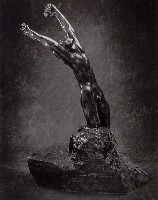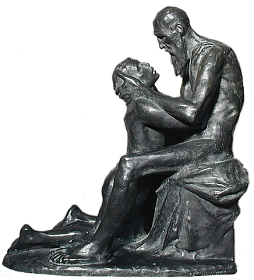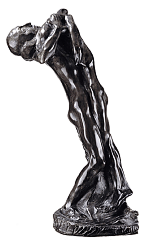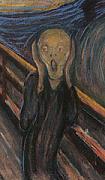Rodin Works: the prodigal son, Child of the century, The Prayer |
|
In this specific case, Rodin referred to the biblical
parable of the younger son who had left his parents to make the best of
his talents and the money received, Rodin's sculpture shows the returned adolescent crying
out his misery in a moment of despair and doubt, begging for forgiveness,
still unsure if his family will accept him home again. Compared to
Constantin Meunier's rather conventional, narrative composition of the
same name, or to
George Minne's work, both placing the errant youth in his father's
solacing arms, Rodin does not anticipate the happy end. In his conversations with Paul Gsell Rodin pointed out he exaggerated the tension of his muscles to underline the misery of the male figure: "As he spoke he showed me on a pedestal nearby one of his most beautiful statues, a young man kneeling, raising suppliant arms to heaven. All his being is drawn out with anguish. His body is thrown backwards. The breast heaves, the throat is tense with despair, and the hands are thrown towards a mysterious being to which they long to cling."
An enlargement was made in 1898; this large-scale version was carved in marble for the Ny Carslberg Glypothek in Copenhagen, with a rocky base and a supporting stone for the stretched back. This carving was later used as a basis for bronze casting. Although the support of the back - not being necessary for a metal sculpture - was omitted, the bronze still shows the webbing between the fingers, reinforcing the hands carved in stone, and the rough surfaces on the back where the struts had been removed. Like in his 'Eve', where the metal strip supporting the ankle of the plaster was transferred into bronze, Rodin deliberately preserved such traces that illustrated the development of his work through various stages and media. |

 and after spending his wealth to the last cent, was heartily welcomed back
by his father, provoking the jealousy of the elder brother who had
and after spending his wealth to the last cent, was heartily welcomed back
by his father, provoking the jealousy of the elder brother who had  safely stayed at home (Luke 15: 11-32). As pointed out by Aida Audeh,
Rodin first time dealt with this subject when producing his sketches for
'The Gates of Hell': In the Fourth Circle of Hell, Dante meets the
Avaricious and the Prodigal, those who hoard and those who squander, both
obsessed - in different ways - with the possession of earthly goods
[Audeh, p. 99].
safely stayed at home (Luke 15: 11-32). As pointed out by Aida Audeh,
Rodin first time dealt with this subject when producing his sketches for
'The Gates of Hell': In the Fourth Circle of Hell, Dante meets the
Avaricious and the Prodigal, those who hoard and those who squander, both
obsessed - in different ways - with the possession of earthly goods
[Audeh, p. 99].